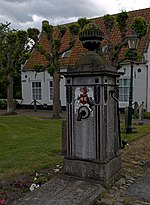Sluis
Cities in the NetherlandsMunicipalities of ZeelandMunicipalities of the Netherlands disestablished in 1995Municipalities of the Netherlands established in 2003Pages including recorded pronunciations ... and 5 more
Pages with Dutch IPAPages with undetermined IPAPopulated places in ZeelandSluisZeelandic Flanders

Sluis (Dutch: [slœys] ; Zeelandic: Sluus [slys]; French: Écluse) is a town and municipality located in the west of Zeelandic Flanders, in the south-western Dutch province of Zeeland. The current incarnation of the municipality has existed since 1 January 2003. The former municipalities of Oostburg and Sluis-Aardenburg merged on that date. The latter of these two municipalities was formed from a merger between the previous municipality named Sluis and the former municipality of Aardenburg in 1995.
Excerpt from the Wikipedia article Sluis (License: CC BY-SA 3.0, Authors, Images).Sluis
Bolwerk Zuid, Sluis
Geographical coordinates (GPS) Address Nearby Places Show on map
Geographical coordinates (GPS)
| Latitude | Longitude |
|---|---|
| N 51.308333333333 ° | E 3.3861111111111 ° |
Address
Vesting Sluis
Bolwerk Zuid
4524 EX Sluis
Zeeland, Netherlands
Open on Google Maps






